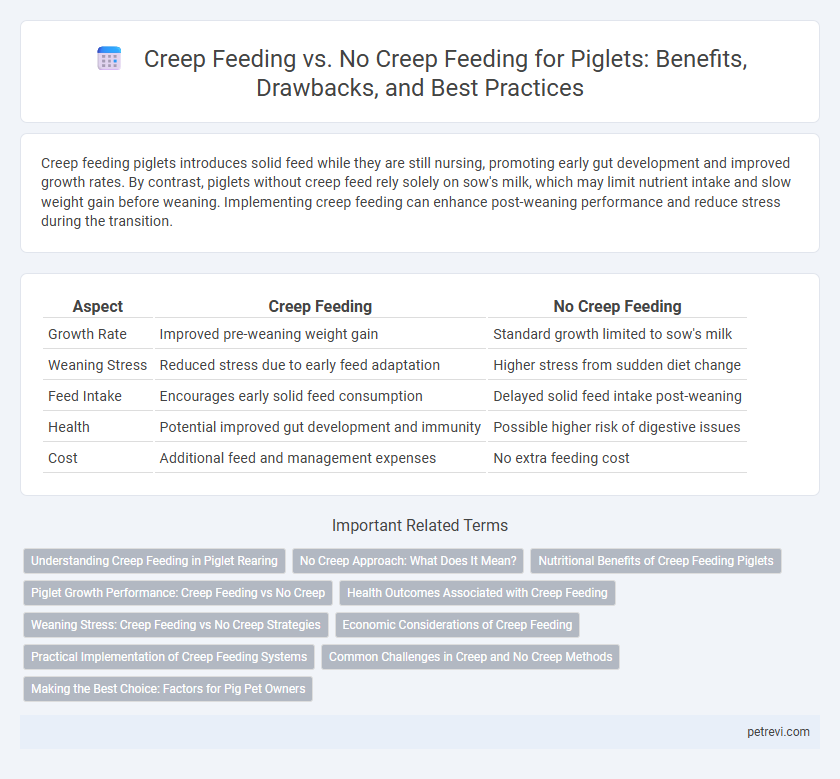Creep feeding piglets introduces solid feed while they are still nursing, promoting early gut development and improved growth rates. By contrast, piglets without creep feed rely solely on sow's milk, which may limit nutrient intake and slow weight gain before weaning. Implementing creep feeding can enhance post-weaning performance and reduce stress during the transition.
Table of Comparison
| Aspect | Creep Feeding | No Creep Feeding |
|---|---|---|
| Growth Rate | Improved pre-weaning weight gain | Standard growth limited to sow's milk |
| Weaning Stress | Reduced stress due to early feed adaptation | Higher stress from sudden diet change |
| Feed Intake | Encourages early solid feed consumption | Delayed solid feed intake post-weaning |
| Health | Potential improved gut development and immunity | Possible higher risk of digestive issues |
| Cost | Additional feed and management expenses | No extra feeding cost |
Understanding Creep Feeding in Piglet Rearing
Creep feeding in piglet rearing enhances early growth by providing supplemental nutrition, leading to improved weaning weights and better post-weaning performance. Piglets given creep feed develop stronger digestive enzymes and adapt more easily to solid diets, reducing stress during weaning. Avoiding creep feeding may result in slower growth rates and increased vulnerability to nutritional deficiencies in the post-weaning phase.
No Creep Approach: What Does It Mean?
The no creep feeding approach for piglets means relying solely on the sow's milk without providing supplemental solid feed during the nursing period. This method encourages natural weaning behaviors and may improve piglets' digestive development by delaying exposure to external feeds. However, growth rates could be slower compared to piglets receiving creep feed, as the nutrient intake depends entirely on sow lactation quality.
Nutritional Benefits of Creep Feeding Piglets
Creep feeding piglets significantly enhances early growth rates by providing nutrient-dense feed that supplements sow milk, ensuring improved protein and energy intake during critical development stages. This targeted nutrition supports optimal gut development and immune function, reducing weaning stress and promoting healthier, more uniform litters. Studies show creep-fed piglets exhibit higher average daily gains and better feed conversion ratios compared to non-creep-fed counterparts.
Piglet Growth Performance: Creep Feeding vs No Creep
Creep feeding significantly enhances piglet growth performance by providing supplemental nutrition that boosts weight gain and improves weaning weights. Piglets receiving creep feed exhibit better feed efficiency and higher average daily gain compared to those without creep feeding. Studies consistently show that creep-fed piglets have improved post-weaning growth rates and overall health status, leading to more robust performance in commercial swine production.
Health Outcomes Associated with Creep Feeding
Creep feeding piglets enhances gut health by promoting early digestive enzyme development and reducing diarrhea incidence during weaning. Studies show piglets receiving creep feed exhibit stronger immune responses and improved nutrient absorption compared to those without creep feed. Health outcomes also include reduced stress levels and better growth rates, contributing to overall herd vitality and reduced mortality.
Weaning Stress: Creep Feeding vs No Creep Strategies
Creep feeding piglets before weaning reduces weaning stress by promoting early adaptation to solid feed, leading to improved gut health and smoother dietary transition. Piglets without creep feed often experience greater weight loss and increased susceptibility to post-weaning diarrhea due to sudden nutritional changes. Implementing creep feeding enhances piglet growth performance and welfare during the critical weaning period.
Economic Considerations of Creep Feeding
Creep feeding piglets can increase weaning weights and improve post-weaning growth rates, leading to higher market value and better feed efficiency. However, the added cost of starter feed, feeder equipment, and labor must be balanced against the potential economic gains. Evaluating feed conversion ratios and market prices is essential to determine if creep feeding provides a profitable return on investment for pig producers.
Practical Implementation of Creep Feeding Systems
Creep feeding systems involve providing piglets with easily accessible, nutrient-dense starter feeds in designated creep areas to promote early growth and ease weaning stress. Practical implementation requires secure, small-space feeders that limit access by sows while ensuring sanitation to prevent disease transmission. Regular monitoring of piglet intake and adjusting feed formulations based on growth performance and litter size optimize the effectiveness of creep feeding programs.
Common Challenges in Creep and No Creep Methods
Creep feeding piglets often leads to challenges such as feed wastage, uneven intake among littermates, and increased labor for feed management. In no creep methods, piglets may face slower growth rates and increased competition for sow milk, resulting in weaker piglets and higher mortality risk. Both approaches require careful management to balance nutritional needs and minimize stress during the weaning transition.
Making the Best Choice: Factors for Pig Pet Owners
Creep feeding piglets supports early growth by providing supplemental nutrition, improving weight gain, and easing weaning stress. Pig owners must consider factors such as feed cost, piglet health status, and space availability when choosing between creep feeding and no creep feed practices. Monitoring piglet development and consulting with a veterinarian ensures the best nutritional strategy tailored to individual piglet needs.
Creep Feeding vs No Creep for Piglets Infographic

 petrevi.com
petrevi.com